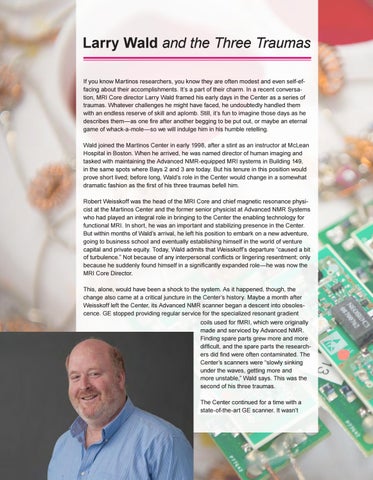Larry Wald and the Three Traumas If you know Martinos researchers, you know they are often modest and even self-effacing about their accomplishments. It’s a part of their charm. In a recent conversation, MRI Core director Larry Wald framed his early days in the Center as a series of traumas. Whatever challenges he might have faced, he undoubtedly handled them with an endless reserve of skill and aplomb. Still, it’s fun to imagine those days as he describes them—as one fire after another begging to be put out, or maybe an eternal game of whack-a-mole—so we will indulge him in his humble retelling. Wald joined the Martinos Center in early 1998, after a stint as an instructor at McLean Hospital in Boston. When he arrived, he was named director of human imaging and tasked with maintaining the Advanced NMR-equipped MRI systems in Building 149, in the same spots where Bays 2 and 3 are today. But his tenure in this position would prove short lived; before long, Wald’s role in the Center would change in a somewhat dramatic fashion as the first of his three traumas befell him. Robert Weisskoff was the head of the MRI Core and chief magnetic resonance physicist at the Martinos Center and the former senior physicist at Advanced NMR Systems who had played an integral role in bringing to the Center the enabling technology for functional MRI. In short, he was an important and stabilizing presence in the Center. But within months of Wald’s arrival, he left his position to embark on a new adventure, going to business school and eventually establishing himself in the world of venture capital and private equity. Today, Wald admits that Weisskoff’s departure “caused a bit of turbulence.” Not because of any interpersonal conflicts or lingering resentment; only because he suddenly found himself in a significantly expanded role—he was now the MRI Core Director. This, alone, would have been a shock to the system. As it happened, though, the change also came at a critical juncture in the Center’s history. Maybe a month after Weisskoff left the Center, its Advanced NMR scanner began a descent into obsolescence. GE stopped providing regular service for the specialized resonant gradient coils used for fMRI, which were originally made and serviced by Advanced NMR. Finding spare parts grew more and more difficult, and the spare parts the researchers did find were often contaminated. The Center’s scanners were “slowly sinking under the waves, getting more and more unstable,” Wald says. This was the second of his three traumas. The Center continued for a time with a state-of-the-art GE scanner. It wasn’t
94










































































